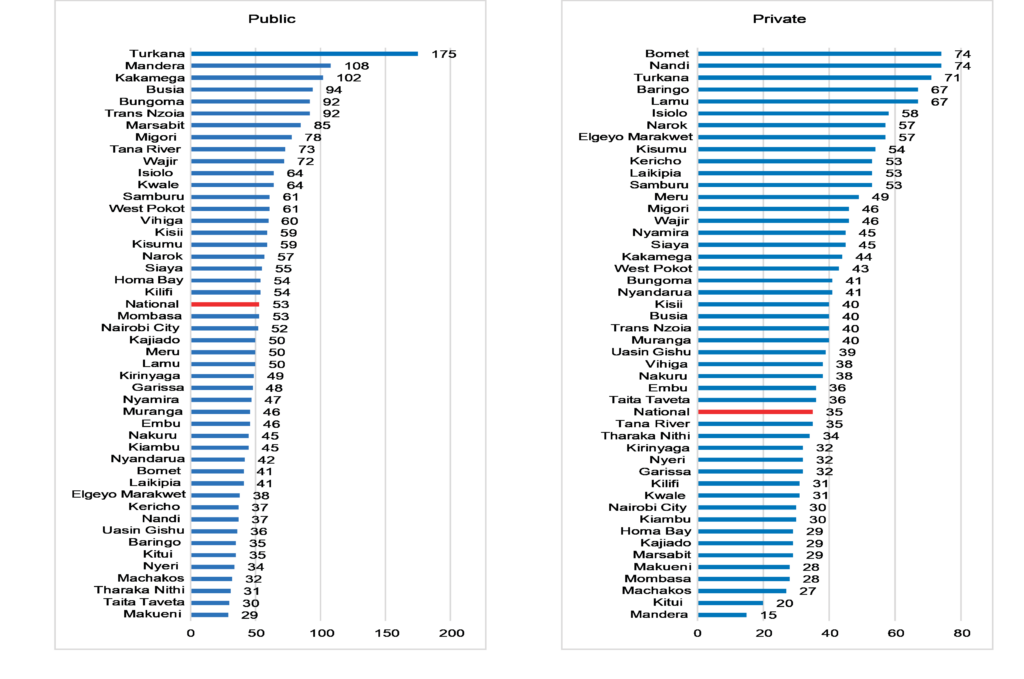Introduction
Pre-primary education is the foundation for character development and learning stimulation, which are important in enhancing social and cognitive preparedness among learners. The Government of Kenya’s aspirations and plans for pre-primary education offered to children ages 4-5 are aligned to Sustainable Development Goal (SDG) 4, which advocates for inclusive and equitable quality education to promote lifelong learning opportunities.
The Constitution of Kenya, Chapter 11, Article 186 (3) gives provision for the devolution of pre-primary education to county governments. In line with Basic Education Act No.14 of 2013, quality assurance in education addresses the expectations of stakeholders and promotes a child-friendly environment that develops learners and meets their needs. The Basic Education Act No.14 of 2013 further emphasizes on the elimination of gender disparities and discrimination in schools. Other adopted legislation includes UNICEF’s 2013 Guidelines on the Rights of the Child to learn and UNESCO’s 2015 guidelines on ensuring countries achieve gender parity in education. The National Education Sector Strategic Plan (NESSP) 2018-2022 was the cornerstone in ensuring quality and equity in education provision.
Equity and quality education in Kenya improves school readiness and reduces cases related to school dropouts and repetition, thus increasing learners’ achievement. The National Government is consistently working with County Governments in standardizing quality assurance to ensure children in all counties access quality childcare and education. However, there are equity gaps in the provision of pre-primary education. This policy blog focuses on ensuring equity in pre-primary education while focusing on access and equity in education.
Status of Pre-Primary Education in Kenya
Over the last decade, the country has made significant strides towards achieving equity in education. In line with the National Education Sector Strategic Plan (NESSP) 2018-2022, access and equity of education are measured through indicators such as gross enrolment levels, school size, gender parity index, learner-to-teacher ratio, learner-to-classroom ratio, and learner-to-toilet ratio.
The Gross Enrolment Ratios (GER) in pre-primary education show low access in arid and semi-arid lands (ASAL) counties[i]. Nairobi City County also had a lower GER range attributed to learners in informal urban settlements such as Kibera, Mukuru kwa Njenga, and Mukuru kwa Reuben. The high enrolment in Turkana County is attributed to development partners’ support for refugee enrolment in the county.
The average school size with at least 100 learners was in 7 counties, and 5 counties had less than 50 learners per school. In Machakos County, a low range on average school size implied enhanced provision in school infrastructure, while a high range in Kakamega County implied over-enrolled centres.
Figure 1 shows the Gender Parity Index (GPI) in enrolment of students in pre-schools across counties.
Figure 1: GPI in pre-school enrolment across counties, 2020

Source: Ministry of Education (2020)
The enrolment of boys and girls in pre-primary schools nationally increased in 2020. The GPI was within the acceptable range of between 0.97 and 1.03, which implies that there was gender parity in access to education in 2020. A total of 22 counties had achieved gender parity while 15 had gender disparity. Isiolo County had a GPI in favour of girls while 6 other ASAL counties had GPI in favour of boys.
In assessing the quality and capacity of pre-schools, the Learner-to-Teacher Ratio (LTR) nationally was below acceptance standards of one teacher and an assistant teacher for every 25 learners[1]. A high range of LTR was recorded in ASAL counties and Trans Nzoia. However, low LTR was recorded in 7 counties, respectively. Figure 2 presents evidence on the number of classroomsin pre-schools in 2020. It compares the Learner-to-Classroom Ratio (LCR) in both public and private schools.
Figure2: Learner-to-classroom ratio at pre-schools educational level across counties, 2020

Source: Ministry of Education (2020)
The Learner-to-Classroom Ratio (LCR) nationally in 2020 was high in public pre-schools while private schools were meeting acceptable standards. A total of 7 counties had a high LCR, which implied low quality of educational inputs and classrooms. On the other hand, 5 counties had a low LCR, which implied that the counties had better educational inputs and classrooms. In private schools, 4 counties had a high LCR while 5 counties had a low LCR.
The Learner-to-Toilet Ratio (LTR) is an important aspect of school infrastructure and sanitation. It impacts the health, dignity, and safety of learners especially for girls. The LTR nationally as per the 2020 data is below the recommended ratio in both public and private pre-schools. Across counties, 4 ASAL counties had the highest levels of LTR for both boys and girls, respectively.
Policy Gaps and Emerging Issues
School infrastructure
School infrastructure encompasses physical facilities and amenities within a school that support teaching, learning, and administrative functions. Kenya is a signatory to the 1989 UN Convention on the Rights of Children and has implemented policies and measures on school safety. UNICEF[ii] on the Rights of the Child acknowledges that every child has a right to learn; on the contrary, poor infrastructure can make learning difficult for many students. The National Education Sector Strategic Plan (NESSP) 2018-2022 on education focuses on improving education quality and equity. However, there are gaps on high levels in Learners-to-Classroom Ratio in public pre-schools, which implies low quality of inputs and classrooms. In addition, the Learner-to-Toilet Ratio and Learner-to-Classroom Ratio were below the recommended ratio in the country.
Gender equity
The Education and Training Sector Gender Policy aims to bridge gender disparity in education[iii]. This is further achieved through establishment of the National Gender Equality Commission to combat gender discrimination and disparities. Kenya has implemented the Education for All Children goal by expanding pre-primary centres to cover Madarasa, Dugsi, and mobile centres. This has promoted equity and inclusiveness among marginalized and disadvantaged groups in the country. However, there are gaps in some counties that have gender disparity in favour of boys.
Teacher staffing ratio policy
The Teacher-Staffing-Ratio policy for pre-schools in Kenya is one teacher and assistant teacher for every 25 learners[iv]. It is critical in determining the quality of education and requires significant investment in recruiting, hiring, and retaining qualified ECDE teachers. It is important to put into consideration learners’ demographics and instructional approach to address the inadequate provision of teachers in counties with high Teacher-to-Learner ratio. However, there are pronounced gap on the Learner-to-Teacher ratio, which is below acceptable standards.
Conclusion and Recommendations
County governments could consider increasing facilities in pre-schools in counties with higher teacher and learners’ ratio. This will go a long way in addressing the infrastructure gap. Investment in school infrastructure will provide a conducive learning environment that contributes to learner engagement, hygiene, and overall academic performance. County Governments under the Basic Education Act No. 14 of 2014 are obliged to provide the required funds for infrastructural development for pre-primary education.
It will be important to increase the number of ECDE teachers and empower them through training in education pedagogies to enhance core competencies. Addressing the staffing ratio allows for personalized attention and tailored instructions, which is crucial for young learners in schools. It will further ensure that County Governments reduce class sizes, thus facilitating individualized learning outcomes. This will contribute to shaping the future of learners.
Counties with the support of stakeholders could address gender disparity in arid and semi-arid lands (ASAL) to create an equitable and inclusive learning environment where all children thrive. This will have a positive effect on learners’ academic performance and overall foundational learning preparedness among all learners.
[1] Ministry of Education (2020)
[i] Ministry of Education (2020)
[ii] United Nations Children’s Fund 2013
[iii] Education and Training Sector Gender Policy, 2015
[iv] Ministry of Education (2020)
Authors: Christopher Mutuiri, Young Professional
Kelins Randiek, Young Professional








